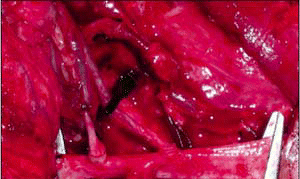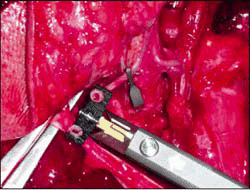ORLANDO, FL-The use of an end-to-side coupling device for anastomosis appears to successfully work in challenging cases involving head and neck reconstruction following resection of cancer, researchers reported here at the 111th annual meeting of the Triological Society.
Explore This Issue
August 2008Although coupling devices to make anastomosis more efficient have been on the medical scene for more than 40 years, most of the use of these devices has been for end-to-end anastomosis procedures.
This is the largest reported series of end-to-side venous anastomoses with an anastomotic coupling device, said Natalya Chernichenko, MD, a resident in surgical otolaryngology at the Yale University School of Medicine in New Haven, CT.
The study demonstrates the feasibility and efficacy of the technique in head and neck reconstruction, she said in her oral report during the Combined Otolaryngology Spring Meeting.

Microvascular free tissue transfers have become the mainstream of reconstruction following resection of head and neck tumors, she said. Despite numerous refinements, microvascular anastomosis is the most challenging aspect of the procedure.
She noted that the anastomotic coupling device was first devised in 1962 (Hakayama) and was further then modified in 1986 (Ostrup and Berggren). Its use in end-to-end venous anastomosis is generally accepted, Dr. Chernichenko said.
She said that use of end-to-side anastomosis overcomes vessel size discrepancy, allows for two or more anastomoses, and may avoid the use of a respiratory venous pump system. Potential drawbacks internal jugular vein thrombosis following neck dissection, and this, of course, may interfere with flap survival, she said.
Several successful reports using sutured anastomoses in end-to-side anastomosis have been reported in which suturing has been employed to accomplish the connection of the blood vessels. She noted one case series of 37 patients in which the coupling device was used. The researchers in that study noted that 33 of the 37 attempts were successful. However, the study also noted that a thick and friable vessel wall is a relative contraindication.
End-to-Side Anastomosis Study
Dr. Chernichenko said that the objective of her study was to demonstrate the success rate of using a coupling device in end-to-side venous anastomoses. We performed a retrospective review series of consecutive cases of microvascular tissue transfers performed at our institution. Flap survival and incidence of thrombosis of venous end-to-side anastomosis were recorded, she noted.

Leave a Reply